Biology Assignment: Cranial Nerves, Insect Behavior, Ecosystems
VerifiedAdded on 2021/08/19
|9
|3245
|97
Homework Assignment
AI Summary
This biology assignment provides a comprehensive overview of three key topics. Firstly, it explains the functions of six pairs of cranial nerves, detailing their sensory and motor roles, from the olfactory nerve for smell to the abducens nerve for eye movement. Secondly, it explores social organization in insects, focusing on termites and bees. The assignment highlights the complex social structures, division of labor, and unique characteristics of these insect societies, including the role of the queen and the different castes. Finally, it emphasizes the importance of animal behavior in ecosystems, discussing its link to biological adaptations, interactions with the environment, and its relevance to human society, neurobiology, and applications in fields such as human behavior analysis and sensory systems applications. The assignment underscores how the study of animal behavior provides insights into various disciplines and contributes to understanding both animal and human life.

Question # 02: Explain the functions of any 06 pairs of cranial nerves.
Your cranial nerves are pairs of nerves that connect your brain to different parts of your head,
neck, and trunk. There are 12 of them, each named for their function or structure.
Each nerve also has a corresponding Roman numeral between I and XII. This is based off their
location from front to back. For example, your olfactory nerve is closest to the front of your
head, so it’s designated as I.
I. Olfactory nerve
The olfactory nerve transmits sensory information to your brain regarding smells that you
encounter. When you inhale aromatic molecules, they dissolve in a moist lining at the roof of
your nasal cavity, called the olfactory epithelium. This stimulates receptors that generate nerve
impulses that move to your olfactory bulb. Your olfactory bulb is an oval-shaped structure that
contains specialized groups of nerve cells.
From the olfactory bulb, nerves pass into your olfactory tract, which is located below the frontal
lobe of your brain. Nerve signals are then sent to areas of your brain concerned with memory and
recognition of smells.
II. Optic nerve
The optic nerve is the sensory nerve that involves vision.
When light enters your eye, it comes into contact with special receptors in your retina called rods
and cones. Rods are found in large numbers and are highly sensitive to light. They’re more
specialized for black and white or night vision. Cones are present in smaller numbers. They have
a lower light sensitivity than rods and are more involved with color vision. The information
received by your rods and cones is transmitted from your retina to your optic nerve. Once inside
your skull, both of your optic nerves meet to form something called the optic chiasm. At the
optic chiasm, nerve fibers from half of each retina form two separate optic tracts. Through each
optic tract, the nerve impulses eventually reach your visual cortex, which then processes the
information. Your visual cortex is located in the back part of your brain.
III. Oculomotor nerve
The oculomotor nerve has two different motor functions: muscle function and pupil response.
Muscle function. Your oculomotor nerve provides motor function to four of the six muscles
around your eyes. These muscles help your eyes move and focus on objects. Pupil response. It
also helps to control the size of your pupil as it responds to light. This nerve originates in the
Your cranial nerves are pairs of nerves that connect your brain to different parts of your head,
neck, and trunk. There are 12 of them, each named for their function or structure.
Each nerve also has a corresponding Roman numeral between I and XII. This is based off their
location from front to back. For example, your olfactory nerve is closest to the front of your
head, so it’s designated as I.
I. Olfactory nerve
The olfactory nerve transmits sensory information to your brain regarding smells that you
encounter. When you inhale aromatic molecules, they dissolve in a moist lining at the roof of
your nasal cavity, called the olfactory epithelium. This stimulates receptors that generate nerve
impulses that move to your olfactory bulb. Your olfactory bulb is an oval-shaped structure that
contains specialized groups of nerve cells.
From the olfactory bulb, nerves pass into your olfactory tract, which is located below the frontal
lobe of your brain. Nerve signals are then sent to areas of your brain concerned with memory and
recognition of smells.
II. Optic nerve
The optic nerve is the sensory nerve that involves vision.
When light enters your eye, it comes into contact with special receptors in your retina called rods
and cones. Rods are found in large numbers and are highly sensitive to light. They’re more
specialized for black and white or night vision. Cones are present in smaller numbers. They have
a lower light sensitivity than rods and are more involved with color vision. The information
received by your rods and cones is transmitted from your retina to your optic nerve. Once inside
your skull, both of your optic nerves meet to form something called the optic chiasm. At the
optic chiasm, nerve fibers from half of each retina form two separate optic tracts. Through each
optic tract, the nerve impulses eventually reach your visual cortex, which then processes the
information. Your visual cortex is located in the back part of your brain.
III. Oculomotor nerve
The oculomotor nerve has two different motor functions: muscle function and pupil response.
Muscle function. Your oculomotor nerve provides motor function to four of the six muscles
around your eyes. These muscles help your eyes move and focus on objects. Pupil response. It
also helps to control the size of your pupil as it responds to light. This nerve originates in the
Paraphrase This Document
Need a fresh take? Get an instant paraphrase of this document with our AI Paraphraser

front part of your midbrain, which is a part of your brainstem. It moves forward from that area
until it reaches the area of your eye sockets.
IV. Trochlear nerve
The trochlear nerve controls your superior oblique muscle. This is the muscle that’s responsible
for downward, outward, and inward eye movements. It emerges from the back part of your
midbrain. Like your oculomotor nerve, it moves forward until it reaches your eye sockets, where
it stimulates the superior oblique muscle.
V. Trigeminal nerve
The trigeminal nerve is the largest of your cranial nerves and has both sensory and motor
functions.
The trigeminal nerve has three divisions, which are:
Ophthalmic. The ophthalmic division sends sensory information from the upper part of your
face, including your forehead, scalp, and upper eyelids.
Maxillary. This division communicates sensory information from the middle part of your face,
including your cheeks, upper lip, and nasal cavity.
Mandibular. The mandibular division has both a sensory and a motor function. It sends sensory
information from your ears, lower lip, and chin. It also controls the movement of muscles within
your jaw and ear.
The trigeminal nerve originates from a group of nuclei — which is a collection of nerve cells —
in the midbrain and medulla regions of your brainstem. Eventually, these nuclei form a separate
sensory root and motor root. The sensory root of your trigeminal nerve branches into the
ophthalmic, maxillary, and mandibular divisions. The motor root of your trigeminal nerve passes
below the sensory root and is only distributed into the mandibular division.
VI. Abducens nerve
The abducens nerve controls another muscle that’s associated with eye movement, called
the lateral rectus muscle. This muscle is involved in outward eye movement. For example, you
would use it to look to the side. This nerve, also called the abducent nerve, starts in
the pons region of your brainstem. It eventually enters your eye socket, where it controls the
lateral rectus muscle.
Q# 3 Explain social organization in insects with examples.
until it reaches the area of your eye sockets.
IV. Trochlear nerve
The trochlear nerve controls your superior oblique muscle. This is the muscle that’s responsible
for downward, outward, and inward eye movements. It emerges from the back part of your
midbrain. Like your oculomotor nerve, it moves forward until it reaches your eye sockets, where
it stimulates the superior oblique muscle.
V. Trigeminal nerve
The trigeminal nerve is the largest of your cranial nerves and has both sensory and motor
functions.
The trigeminal nerve has three divisions, which are:
Ophthalmic. The ophthalmic division sends sensory information from the upper part of your
face, including your forehead, scalp, and upper eyelids.
Maxillary. This division communicates sensory information from the middle part of your face,
including your cheeks, upper lip, and nasal cavity.
Mandibular. The mandibular division has both a sensory and a motor function. It sends sensory
information from your ears, lower lip, and chin. It also controls the movement of muscles within
your jaw and ear.
The trigeminal nerve originates from a group of nuclei — which is a collection of nerve cells —
in the midbrain and medulla regions of your brainstem. Eventually, these nuclei form a separate
sensory root and motor root. The sensory root of your trigeminal nerve branches into the
ophthalmic, maxillary, and mandibular divisions. The motor root of your trigeminal nerve passes
below the sensory root and is only distributed into the mandibular division.
VI. Abducens nerve
The abducens nerve controls another muscle that’s associated with eye movement, called
the lateral rectus muscle. This muscle is involved in outward eye movement. For example, you
would use it to look to the side. This nerve, also called the abducent nerve, starts in
the pons region of your brainstem. It eventually enters your eye socket, where it controls the
lateral rectus muscle.
Q# 3 Explain social organization in insects with examples.

In insects social life has evolved only in two orders, namely, Isoptera (termites) and
Hymenoptera (bees, wasps and ants) which make a nest and live in colonies of thousands of
individuals that practice division of labour and social interaction.
Examples:
SOCIAL LIFE IN TERMITES
Termites were the first animals which started living in colonies and developed a well organised
social system about 300 million years ago, much earlier than honey bees, ants and human beings.
Although termites do not exceed 3-4 mm in size, their queen is a 4 inch long giant that lies in the
royal chamber motionless, since its legs are too small to move its enormous body. Hence
workers have to take care of all its daily chores. Termite queen is an egg-laying machine that
reproduces at an astonishing rate of two eggs per second. Generally the queen of a termite colony
can lay 6,000 to 7,000 eggs per day, and can live for 15 to 20 years. The other
castes, workers and soldiers are highly devoted to the colony, working incessantly and tirelessly,
demanding nothing in return from the society. Soldiers have long dagger-like mandibles with
which they defend their nest and workers chew the wood to feed to the queen and larvae and
grow fungus gardens for lean periods. Nasutes are specialized soldiers which specialize in
chemical warfare. They produce a jet of highly corrosive chemical from their bodies that can
dissolve the skin of enemies and can also help in making galleries through the rocks.
SOCIAL STRUCTURE OF A BEE COLONY
The population of a healthy bee hive in spring and honey flow period may contain 40,000-80,000
individuals but the population declines in winter and extreme summer. There is remarkable order
in the hive and no conflicts are seen among the members. Queen is one and a half times larger
than the workers and is the only fertile female in the hive. Queen keeps the colony together by
secreting a pheromone called queen substance from its mandibular glands. In multiqueen
colonies, young queens after emergence attempt to sting and kill the rival queens.
Hymenoptera (bees, wasps and ants) which make a nest and live in colonies of thousands of
individuals that practice division of labour and social interaction.
Examples:
SOCIAL LIFE IN TERMITES
Termites were the first animals which started living in colonies and developed a well organised
social system about 300 million years ago, much earlier than honey bees, ants and human beings.
Although termites do not exceed 3-4 mm in size, their queen is a 4 inch long giant that lies in the
royal chamber motionless, since its legs are too small to move its enormous body. Hence
workers have to take care of all its daily chores. Termite queen is an egg-laying machine that
reproduces at an astonishing rate of two eggs per second. Generally the queen of a termite colony
can lay 6,000 to 7,000 eggs per day, and can live for 15 to 20 years. The other
castes, workers and soldiers are highly devoted to the colony, working incessantly and tirelessly,
demanding nothing in return from the society. Soldiers have long dagger-like mandibles with
which they defend their nest and workers chew the wood to feed to the queen and larvae and
grow fungus gardens for lean periods. Nasutes are specialized soldiers which specialize in
chemical warfare. They produce a jet of highly corrosive chemical from their bodies that can
dissolve the skin of enemies and can also help in making galleries through the rocks.
SOCIAL STRUCTURE OF A BEE COLONY
The population of a healthy bee hive in spring and honey flow period may contain 40,000-80,000
individuals but the population declines in winter and extreme summer. There is remarkable order
in the hive and no conflicts are seen among the members. Queen is one and a half times larger
than the workers and is the only fertile female in the hive. Queen keeps the colony together by
secreting a pheromone called queen substance from its mandibular glands. In multiqueen
colonies, young queens after emergence attempt to sting and kill the rival queens.
⊘ This is a preview!⊘
Do you want full access?
Subscribe today to unlock all pages.

Trusted by 1+ million students worldwide
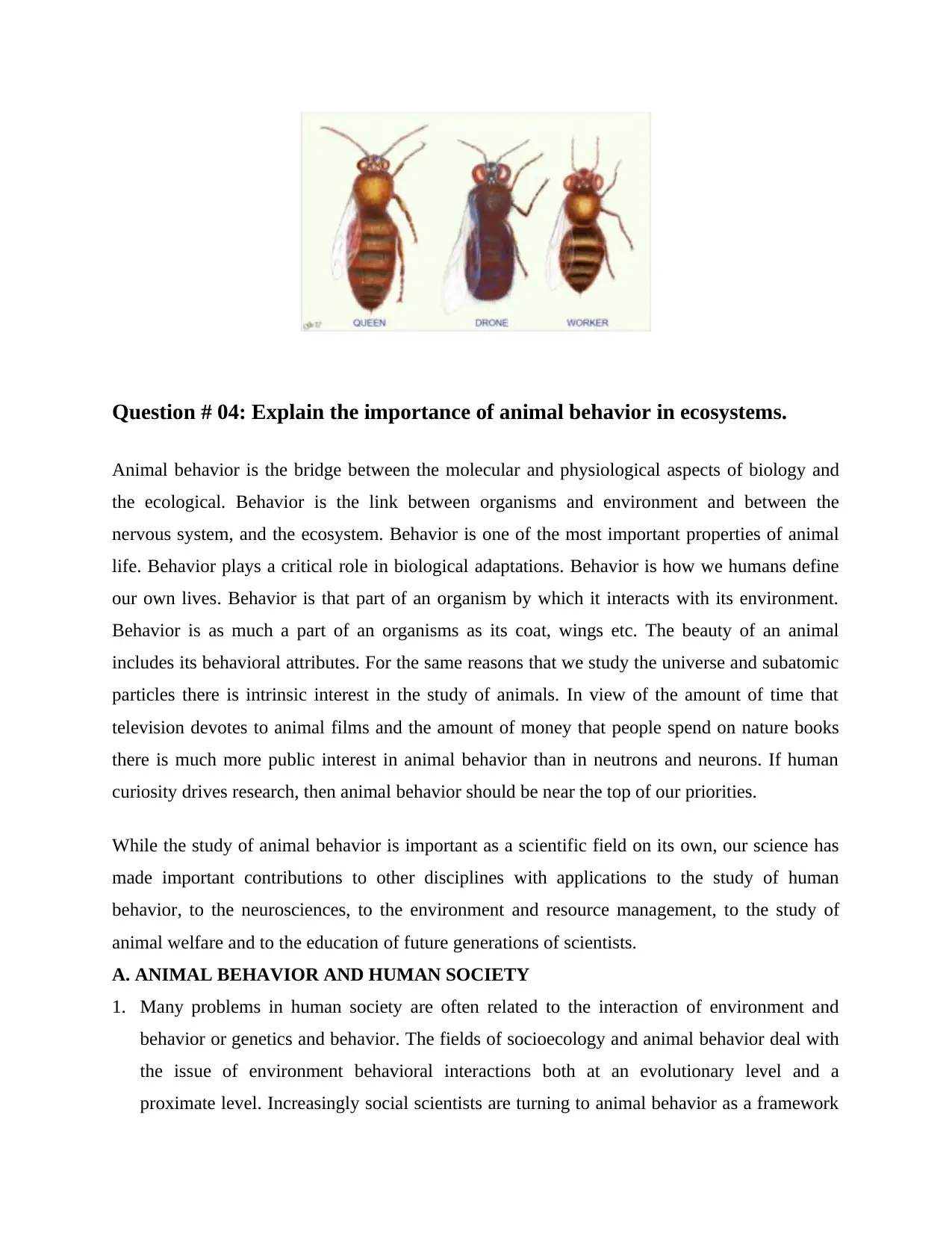
Question # 04: Explain the importance of animal behavior in ecosystems.
Animal behavior is the bridge between the molecular and physiological aspects of biology and
the ecological. Behavior is the link between organisms and environment and between the
nervous system, and the ecosystem. Behavior is one of the most important properties of animal
life. Behavior plays a critical role in biological adaptations. Behavior is how we humans define
our own lives. Behavior is that part of an organism by which it interacts with its environment.
Behavior is as much a part of an organisms as its coat, wings etc. The beauty of an animal
includes its behavioral attributes. For the same reasons that we study the universe and subatomic
particles there is intrinsic interest in the study of animals. In view of the amount of time that
television devotes to animal films and the amount of money that people spend on nature books
there is much more public interest in animal behavior than in neutrons and neurons. If human
curiosity drives research, then animal behavior should be near the top of our priorities.
While the study of animal behavior is important as a scientific field on its own, our science has
made important contributions to other disciplines with applications to the study of human
behavior, to the neurosciences, to the environment and resource management, to the study of
animal welfare and to the education of future generations of scientists.
A. ANIMAL BEHAVIOR AND HUMAN SOCIETY
1. Many problems in human society are often related to the interaction of environment and
behavior or genetics and behavior. The fields of socioecology and animal behavior deal with
the issue of environment behavioral interactions both at an evolutionary level and a
proximate level. Increasingly social scientists are turning to animal behavior as a framework
Animal behavior is the bridge between the molecular and physiological aspects of biology and
the ecological. Behavior is the link between organisms and environment and between the
nervous system, and the ecosystem. Behavior is one of the most important properties of animal
life. Behavior plays a critical role in biological adaptations. Behavior is how we humans define
our own lives. Behavior is that part of an organism by which it interacts with its environment.
Behavior is as much a part of an organisms as its coat, wings etc. The beauty of an animal
includes its behavioral attributes. For the same reasons that we study the universe and subatomic
particles there is intrinsic interest in the study of animals. In view of the amount of time that
television devotes to animal films and the amount of money that people spend on nature books
there is much more public interest in animal behavior than in neutrons and neurons. If human
curiosity drives research, then animal behavior should be near the top of our priorities.
While the study of animal behavior is important as a scientific field on its own, our science has
made important contributions to other disciplines with applications to the study of human
behavior, to the neurosciences, to the environment and resource management, to the study of
animal welfare and to the education of future generations of scientists.
A. ANIMAL BEHAVIOR AND HUMAN SOCIETY
1. Many problems in human society are often related to the interaction of environment and
behavior or genetics and behavior. The fields of socioecology and animal behavior deal with
the issue of environment behavioral interactions both at an evolutionary level and a
proximate level. Increasingly social scientists are turning to animal behavior as a framework
Paraphrase This Document
Need a fresh take? Get an instant paraphrase of this document with our AI Paraphraser
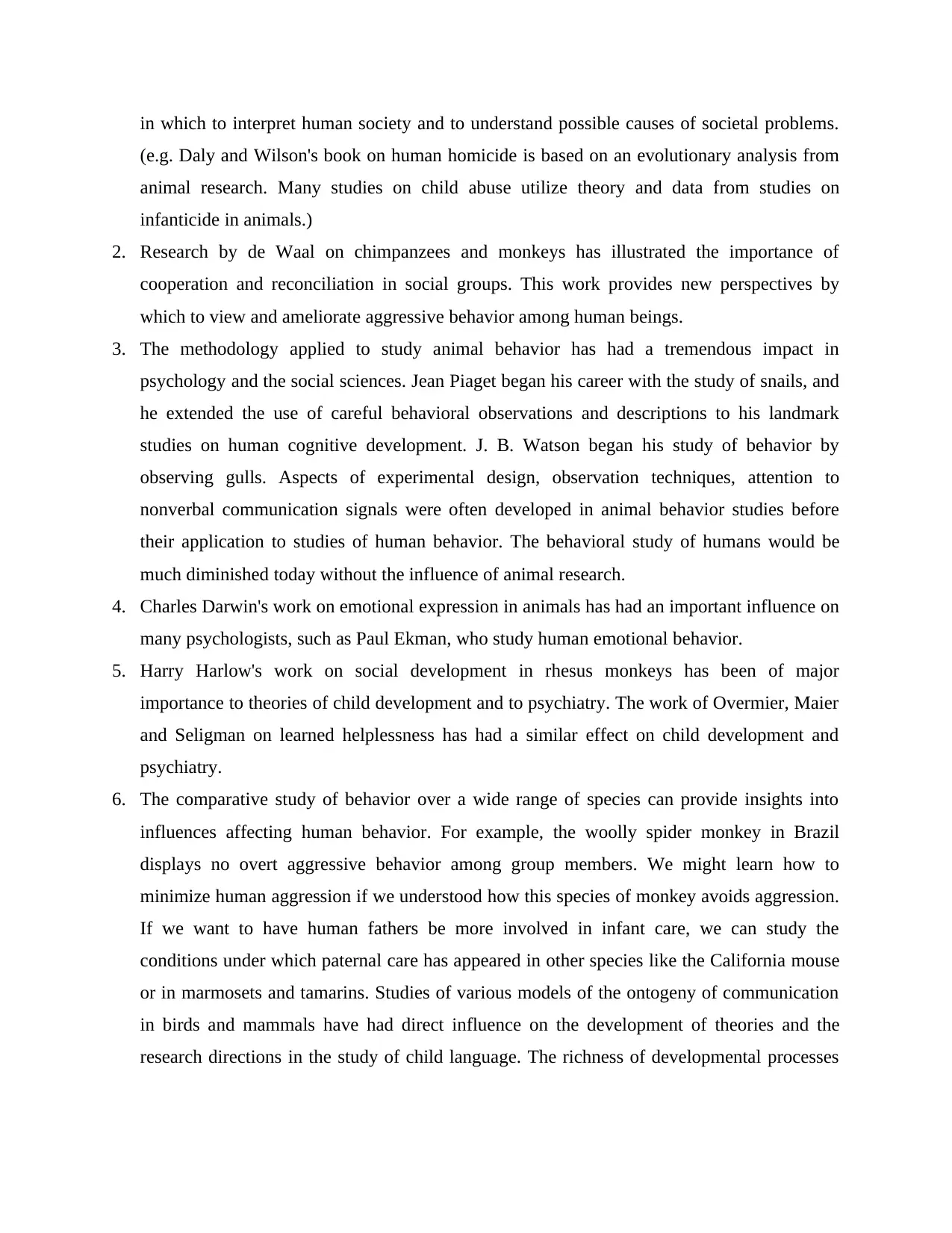
in which to interpret human society and to understand possible causes of societal problems.
(e.g. Daly and Wilson's book on human homicide is based on an evolutionary analysis from
animal research. Many studies on child abuse utilize theory and data from studies on
infanticide in animals.)
2. Research by de Waal on chimpanzees and monkeys has illustrated the importance of
cooperation and reconciliation in social groups. This work provides new perspectives by
which to view and ameliorate aggressive behavior among human beings.
3. The methodology applied to study animal behavior has had a tremendous impact in
psychology and the social sciences. Jean Piaget began his career with the study of snails, and
he extended the use of careful behavioral observations and descriptions to his landmark
studies on human cognitive development. J. B. Watson began his study of behavior by
observing gulls. Aspects of experimental design, observation techniques, attention to
nonverbal communication signals were often developed in animal behavior studies before
their application to studies of human behavior. The behavioral study of humans would be
much diminished today without the influence of animal research.
4. Charles Darwin's work on emotional expression in animals has had an important influence on
many psychologists, such as Paul Ekman, who study human emotional behavior.
5. Harry Harlow's work on social development in rhesus monkeys has been of major
importance to theories of child development and to psychiatry. The work of Overmier, Maier
and Seligman on learned helplessness has had a similar effect on child development and
psychiatry.
6. The comparative study of behavior over a wide range of species can provide insights into
influences affecting human behavior. For example, the woolly spider monkey in Brazil
displays no overt aggressive behavior among group members. We might learn how to
minimize human aggression if we understood how this species of monkey avoids aggression.
If we want to have human fathers be more involved in infant care, we can study the
conditions under which paternal care has appeared in other species like the California mouse
or in marmosets and tamarins. Studies of various models of the ontogeny of communication
in birds and mammals have had direct influence on the development of theories and the
research directions in the study of child language. The richness of developmental processes
(e.g. Daly and Wilson's book on human homicide is based on an evolutionary analysis from
animal research. Many studies on child abuse utilize theory and data from studies on
infanticide in animals.)
2. Research by de Waal on chimpanzees and monkeys has illustrated the importance of
cooperation and reconciliation in social groups. This work provides new perspectives by
which to view and ameliorate aggressive behavior among human beings.
3. The methodology applied to study animal behavior has had a tremendous impact in
psychology and the social sciences. Jean Piaget began his career with the study of snails, and
he extended the use of careful behavioral observations and descriptions to his landmark
studies on human cognitive development. J. B. Watson began his study of behavior by
observing gulls. Aspects of experimental design, observation techniques, attention to
nonverbal communication signals were often developed in animal behavior studies before
their application to studies of human behavior. The behavioral study of humans would be
much diminished today without the influence of animal research.
4. Charles Darwin's work on emotional expression in animals has had an important influence on
many psychologists, such as Paul Ekman, who study human emotional behavior.
5. Harry Harlow's work on social development in rhesus monkeys has been of major
importance to theories of child development and to psychiatry. The work of Overmier, Maier
and Seligman on learned helplessness has had a similar effect on child development and
psychiatry.
6. The comparative study of behavior over a wide range of species can provide insights into
influences affecting human behavior. For example, the woolly spider monkey in Brazil
displays no overt aggressive behavior among group members. We might learn how to
minimize human aggression if we understood how this species of monkey avoids aggression.
If we want to have human fathers be more involved in infant care, we can study the
conditions under which paternal care has appeared in other species like the California mouse
or in marmosets and tamarins. Studies of various models of the ontogeny of communication
in birds and mammals have had direct influence on the development of theories and the
research directions in the study of child language. The richness of developmental processes
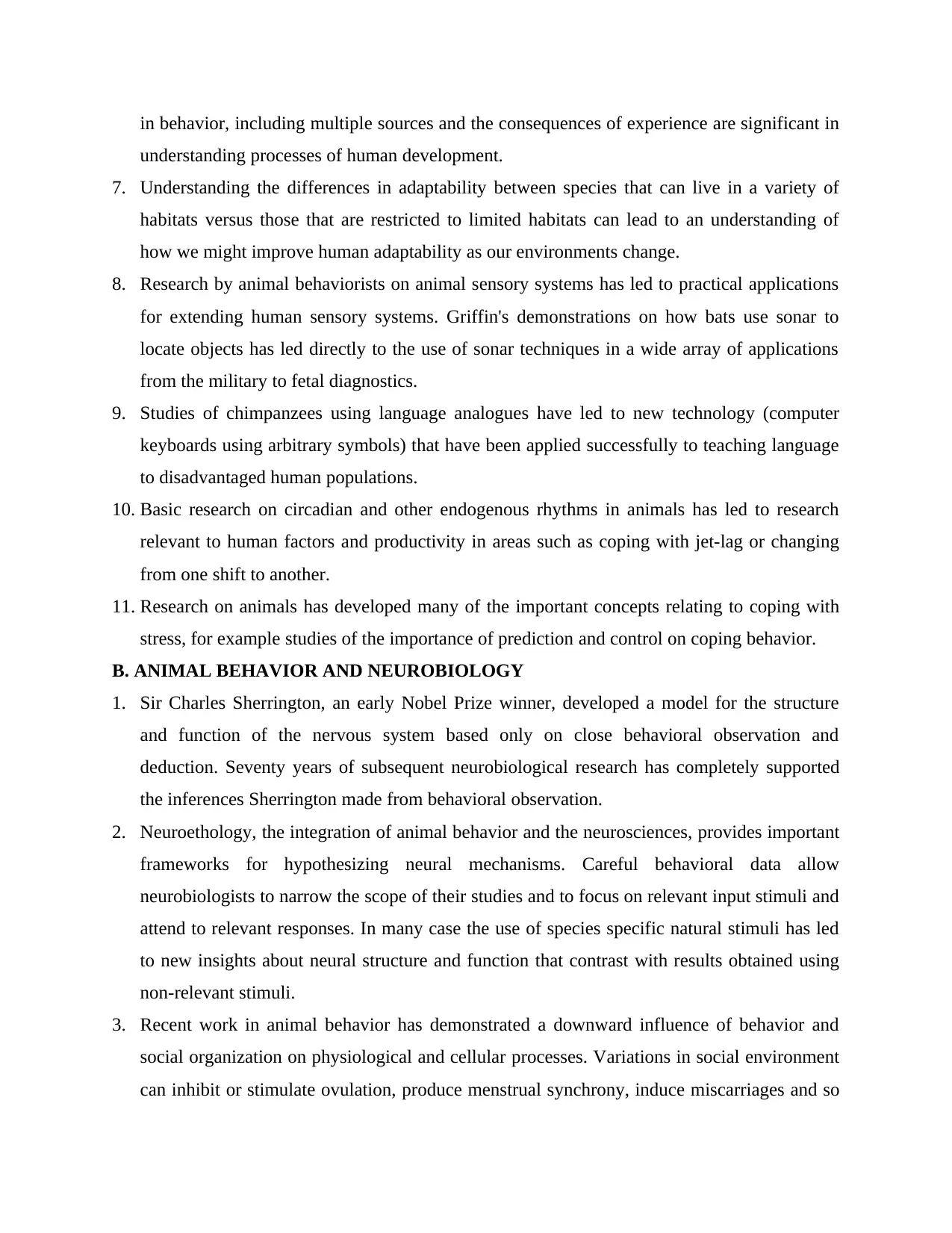
in behavior, including multiple sources and the consequences of experience are significant in
understanding processes of human development.
7. Understanding the differences in adaptability between species that can live in a variety of
habitats versus those that are restricted to limited habitats can lead to an understanding of
how we might improve human adaptability as our environments change.
8. Research by animal behaviorists on animal sensory systems has led to practical applications
for extending human sensory systems. Griffin's demonstrations on how bats use sonar to
locate objects has led directly to the use of sonar techniques in a wide array of applications
from the military to fetal diagnostics.
9. Studies of chimpanzees using language analogues have led to new technology (computer
keyboards using arbitrary symbols) that have been applied successfully to teaching language
to disadvantaged human populations.
10. Basic research on circadian and other endogenous rhythms in animals has led to research
relevant to human factors and productivity in areas such as coping with jet-lag or changing
from one shift to another.
11. Research on animals has developed many of the important concepts relating to coping with
stress, for example studies of the importance of prediction and control on coping behavior.
B. ANIMAL BEHAVIOR AND NEUROBIOLOGY
1. Sir Charles Sherrington, an early Nobel Prize winner, developed a model for the structure
and function of the nervous system based only on close behavioral observation and
deduction. Seventy years of subsequent neurobiological research has completely supported
the inferences Sherrington made from behavioral observation.
2. Neuroethology, the integration of animal behavior and the neurosciences, provides important
frameworks for hypothesizing neural mechanisms. Careful behavioral data allow
neurobiologists to narrow the scope of their studies and to focus on relevant input stimuli and
attend to relevant responses. In many case the use of species specific natural stimuli has led
to new insights about neural structure and function that contrast with results obtained using
non-relevant stimuli.
3. Recent work in animal behavior has demonstrated a downward influence of behavior and
social organization on physiological and cellular processes. Variations in social environment
can inhibit or stimulate ovulation, produce menstrual synchrony, induce miscarriages and so
understanding processes of human development.
7. Understanding the differences in adaptability between species that can live in a variety of
habitats versus those that are restricted to limited habitats can lead to an understanding of
how we might improve human adaptability as our environments change.
8. Research by animal behaviorists on animal sensory systems has led to practical applications
for extending human sensory systems. Griffin's demonstrations on how bats use sonar to
locate objects has led directly to the use of sonar techniques in a wide array of applications
from the military to fetal diagnostics.
9. Studies of chimpanzees using language analogues have led to new technology (computer
keyboards using arbitrary symbols) that have been applied successfully to teaching language
to disadvantaged human populations.
10. Basic research on circadian and other endogenous rhythms in animals has led to research
relevant to human factors and productivity in areas such as coping with jet-lag or changing
from one shift to another.
11. Research on animals has developed many of the important concepts relating to coping with
stress, for example studies of the importance of prediction and control on coping behavior.
B. ANIMAL BEHAVIOR AND NEUROBIOLOGY
1. Sir Charles Sherrington, an early Nobel Prize winner, developed a model for the structure
and function of the nervous system based only on close behavioral observation and
deduction. Seventy years of subsequent neurobiological research has completely supported
the inferences Sherrington made from behavioral observation.
2. Neuroethology, the integration of animal behavior and the neurosciences, provides important
frameworks for hypothesizing neural mechanisms. Careful behavioral data allow
neurobiologists to narrow the scope of their studies and to focus on relevant input stimuli and
attend to relevant responses. In many case the use of species specific natural stimuli has led
to new insights about neural structure and function that contrast with results obtained using
non-relevant stimuli.
3. Recent work in animal behavior has demonstrated a downward influence of behavior and
social organization on physiological and cellular processes. Variations in social environment
can inhibit or stimulate ovulation, produce menstrual synchrony, induce miscarriages and so
⊘ This is a preview!⊘
Do you want full access?
Subscribe today to unlock all pages.

Trusted by 1+ million students worldwide
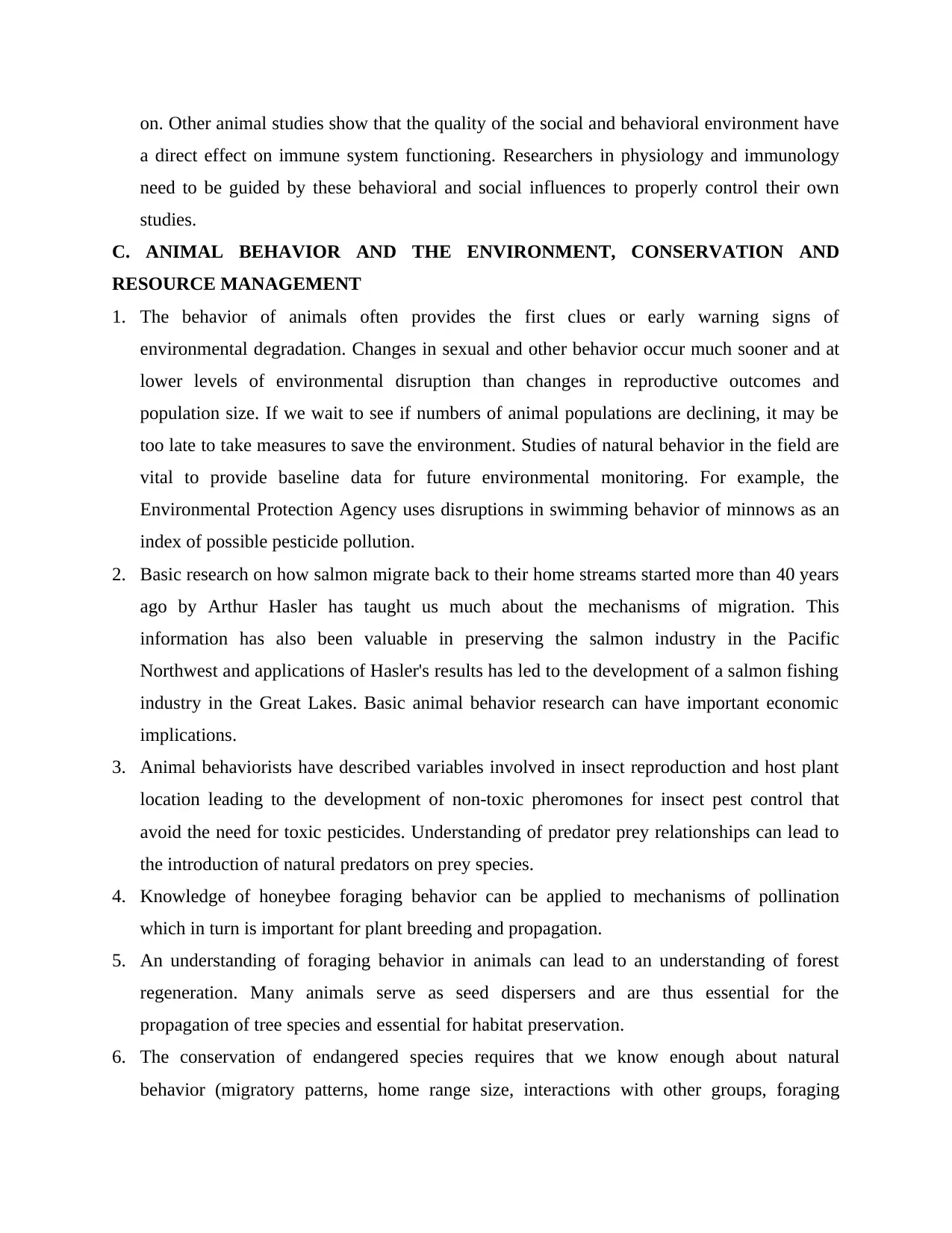
on. Other animal studies show that the quality of the social and behavioral environment have
a direct effect on immune system functioning. Researchers in physiology and immunology
need to be guided by these behavioral and social influences to properly control their own
studies.
C. ANIMAL BEHAVIOR AND THE ENVIRONMENT, CONSERVATION AND
RESOURCE MANAGEMENT
1. The behavior of animals often provides the first clues or early warning signs of
environmental degradation. Changes in sexual and other behavior occur much sooner and at
lower levels of environmental disruption than changes in reproductive outcomes and
population size. If we wait to see if numbers of animal populations are declining, it may be
too late to take measures to save the environment. Studies of natural behavior in the field are
vital to provide baseline data for future environmental monitoring. For example, the
Environmental Protection Agency uses disruptions in swimming behavior of minnows as an
index of possible pesticide pollution.
2. Basic research on how salmon migrate back to their home streams started more than 40 years
ago by Arthur Hasler has taught us much about the mechanisms of migration. This
information has also been valuable in preserving the salmon industry in the Pacific
Northwest and applications of Hasler's results has led to the development of a salmon fishing
industry in the Great Lakes. Basic animal behavior research can have important economic
implications.
3. Animal behaviorists have described variables involved in insect reproduction and host plant
location leading to the development of non-toxic pheromones for insect pest control that
avoid the need for toxic pesticides. Understanding of predator prey relationships can lead to
the introduction of natural predators on prey species.
4. Knowledge of honeybee foraging behavior can be applied to mechanisms of pollination
which in turn is important for plant breeding and propagation.
5. An understanding of foraging behavior in animals can lead to an understanding of forest
regeneration. Many animals serve as seed dispersers and are thus essential for the
propagation of tree species and essential for habitat preservation.
6. The conservation of endangered species requires that we know enough about natural
behavior (migratory patterns, home range size, interactions with other groups, foraging
a direct effect on immune system functioning. Researchers in physiology and immunology
need to be guided by these behavioral and social influences to properly control their own
studies.
C. ANIMAL BEHAVIOR AND THE ENVIRONMENT, CONSERVATION AND
RESOURCE MANAGEMENT
1. The behavior of animals often provides the first clues or early warning signs of
environmental degradation. Changes in sexual and other behavior occur much sooner and at
lower levels of environmental disruption than changes in reproductive outcomes and
population size. If we wait to see if numbers of animal populations are declining, it may be
too late to take measures to save the environment. Studies of natural behavior in the field are
vital to provide baseline data for future environmental monitoring. For example, the
Environmental Protection Agency uses disruptions in swimming behavior of minnows as an
index of possible pesticide pollution.
2. Basic research on how salmon migrate back to their home streams started more than 40 years
ago by Arthur Hasler has taught us much about the mechanisms of migration. This
information has also been valuable in preserving the salmon industry in the Pacific
Northwest and applications of Hasler's results has led to the development of a salmon fishing
industry in the Great Lakes. Basic animal behavior research can have important economic
implications.
3. Animal behaviorists have described variables involved in insect reproduction and host plant
location leading to the development of non-toxic pheromones for insect pest control that
avoid the need for toxic pesticides. Understanding of predator prey relationships can lead to
the introduction of natural predators on prey species.
4. Knowledge of honeybee foraging behavior can be applied to mechanisms of pollination
which in turn is important for plant breeding and propagation.
5. An understanding of foraging behavior in animals can lead to an understanding of forest
regeneration. Many animals serve as seed dispersers and are thus essential for the
propagation of tree species and essential for habitat preservation.
6. The conservation of endangered species requires that we know enough about natural
behavior (migratory patterns, home range size, interactions with other groups, foraging
Paraphrase This Document
Need a fresh take? Get an instant paraphrase of this document with our AI Paraphraser
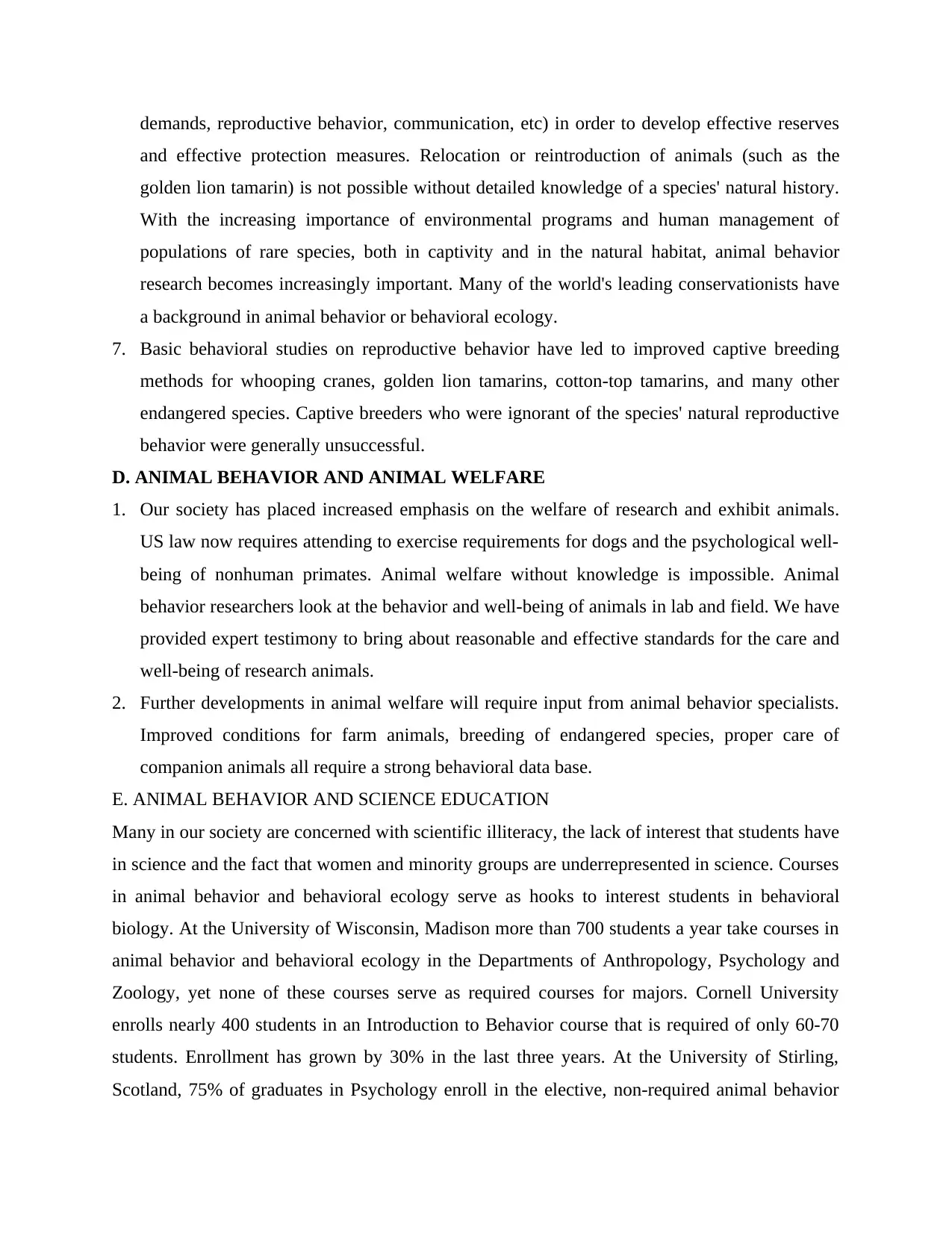
demands, reproductive behavior, communication, etc) in order to develop effective reserves
and effective protection measures. Relocation or reintroduction of animals (such as the
golden lion tamarin) is not possible without detailed knowledge of a species' natural history.
With the increasing importance of environmental programs and human management of
populations of rare species, both in captivity and in the natural habitat, animal behavior
research becomes increasingly important. Many of the world's leading conservationists have
a background in animal behavior or behavioral ecology.
7. Basic behavioral studies on reproductive behavior have led to improved captive breeding
methods for whooping cranes, golden lion tamarins, cotton-top tamarins, and many other
endangered species. Captive breeders who were ignorant of the species' natural reproductive
behavior were generally unsuccessful.
D. ANIMAL BEHAVIOR AND ANIMAL WELFARE
1. Our society has placed increased emphasis on the welfare of research and exhibit animals.
US law now requires attending to exercise requirements for dogs and the psychological well-
being of nonhuman primates. Animal welfare without knowledge is impossible. Animal
behavior researchers look at the behavior and well-being of animals in lab and field. We have
provided expert testimony to bring about reasonable and effective standards for the care and
well-being of research animals.
2. Further developments in animal welfare will require input from animal behavior specialists.
Improved conditions for farm animals, breeding of endangered species, proper care of
companion animals all require a strong behavioral data base.
E. ANIMAL BEHAVIOR AND SCIENCE EDUCATION
Many in our society are concerned with scientific illiteracy, the lack of interest that students have
in science and the fact that women and minority groups are underrepresented in science. Courses
in animal behavior and behavioral ecology serve as hooks to interest students in behavioral
biology. At the University of Wisconsin, Madison more than 700 students a year take courses in
animal behavior and behavioral ecology in the Departments of Anthropology, Psychology and
Zoology, yet none of these courses serve as required courses for majors. Cornell University
enrolls nearly 400 students in an Introduction to Behavior course that is required of only 60-70
students. Enrollment has grown by 30% in the last three years. At the University of Stirling,
Scotland, 75% of graduates in Psychology enroll in the elective, non-required animal behavior
and effective protection measures. Relocation or reintroduction of animals (such as the
golden lion tamarin) is not possible without detailed knowledge of a species' natural history.
With the increasing importance of environmental programs and human management of
populations of rare species, both in captivity and in the natural habitat, animal behavior
research becomes increasingly important. Many of the world's leading conservationists have
a background in animal behavior or behavioral ecology.
7. Basic behavioral studies on reproductive behavior have led to improved captive breeding
methods for whooping cranes, golden lion tamarins, cotton-top tamarins, and many other
endangered species. Captive breeders who were ignorant of the species' natural reproductive
behavior were generally unsuccessful.
D. ANIMAL BEHAVIOR AND ANIMAL WELFARE
1. Our society has placed increased emphasis on the welfare of research and exhibit animals.
US law now requires attending to exercise requirements for dogs and the psychological well-
being of nonhuman primates. Animal welfare without knowledge is impossible. Animal
behavior researchers look at the behavior and well-being of animals in lab and field. We have
provided expert testimony to bring about reasonable and effective standards for the care and
well-being of research animals.
2. Further developments in animal welfare will require input from animal behavior specialists.
Improved conditions for farm animals, breeding of endangered species, proper care of
companion animals all require a strong behavioral data base.
E. ANIMAL BEHAVIOR AND SCIENCE EDUCATION
Many in our society are concerned with scientific illiteracy, the lack of interest that students have
in science and the fact that women and minority groups are underrepresented in science. Courses
in animal behavior and behavioral ecology serve as hooks to interest students in behavioral
biology. At the University of Wisconsin, Madison more than 700 students a year take courses in
animal behavior and behavioral ecology in the Departments of Anthropology, Psychology and
Zoology, yet none of these courses serve as required courses for majors. Cornell University
enrolls nearly 400 students in an Introduction to Behavior course that is required of only 60-70
students. Enrollment has grown by 30% in the last three years. At the University of Stirling,
Scotland, 75% of graduates in Psychology enroll in the elective, non-required animal behavior

course. At the University of Washington, Seattle, more than 300 students enroll each quarter in a
basic animal behavior class. Similar results can be found on many other campuses.
For many students, especially females, these courses are their first introduction to behavioral
biology. Many female undergraduates approach us to discuss graduate school and research
careers after taking these courses. 75% or more of our graduate applicants are female. A good
proportion of students enrolled in animal behavior courses become motivated for research
careers, but there is little hope to offer them that they will actually be able to become practicing
scientists when they finish due to severe limitations on research funding.
basic animal behavior class. Similar results can be found on many other campuses.
For many students, especially females, these courses are their first introduction to behavioral
biology. Many female undergraduates approach us to discuss graduate school and research
careers after taking these courses. 75% or more of our graduate applicants are female. A good
proportion of students enrolled in animal behavior courses become motivated for research
careers, but there is little hope to offer them that they will actually be able to become practicing
scientists when they finish due to severe limitations on research funding.
⊘ This is a preview!⊘
Do you want full access?
Subscribe today to unlock all pages.

Trusted by 1+ million students worldwide
1 out of 9
Your All-in-One AI-Powered Toolkit for Academic Success.
+13062052269
info@desklib.com
Available 24*7 on WhatsApp / Email
![[object Object]](/_next/static/media/star-bottom.7253800d.svg)
Unlock your academic potential
Copyright © 2020–2025 A2Z Services. All Rights Reserved. Developed and managed by ZUCOL.
